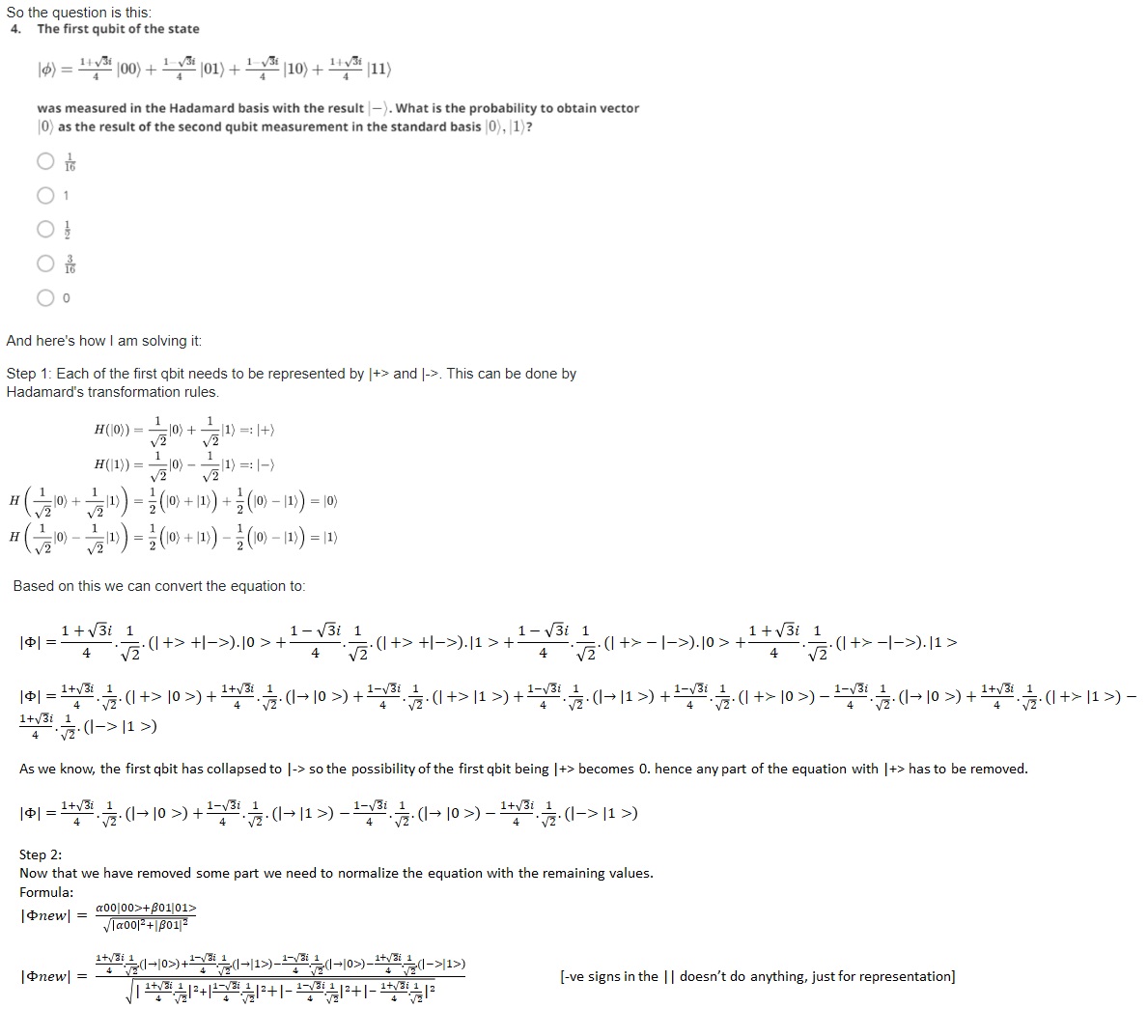This is going to look like homework because it is from a self-inflected Coursera course. I have already found the answer by trial and error but I want to clear my logic. (Coz I'm not getting sleep otherwise and I can't ask the question in Coursera without revealing too much and ruining the quiz for others.)
Instead of doing the long math here I used the online calculator: here’s a link:
Once again online calculator to help : Link:
The result comes out as 3/4 but the expected answer is set as 1/2. Can anyone help? I might be missing something very simple.
Edit
The complete solution:
$$\begin{aligned}|\phi| = {(1+ \sqrt{3}i) \over 4\sqrt{2}}(|+\rangle +|-\rangle)|0\rangle+{(1- \sqrt{3}i)\over 4\sqrt{2}}(|+\rangle + |-\rangle)|1\rangle \\ + {(1- \sqrt{3}i) \over 4\sqrt{2}}(|+\rangle-|-\rangle)|0\rangle+{(1+ \sqrt{3}i) \over 4\sqrt{2}}(|+\rangle - |-\rangle)|1\rangle\end{aligned}$$
By dropping the $|+\rangle$ combinations we are left with
$$\begin{aligned}|\phi| = {(1+ \sqrt{3}i) \over 4\sqrt{2}}|-\rangle|0\rangle-{(1- \sqrt{3}i) \over 4\sqrt{2}}\rangle|1\rangle+{(1- \sqrt{3}i) \over 4\sqrt{2}}|-\rangle|0\rangle-{(1+ \sqrt{3}i) \over 4\sqrt{2}}|-\rangle|1\rangle\end{aligned}$$
This is where I was wrong to not solve it even further.
$$|\phi| = ({(1+ \sqrt{3}i) \over 4\sqrt{2}}-{(1- \sqrt{3}i) \over 4\sqrt{2}})|-\rangle|0\rangle+({(1- \sqrt{3}i) \over 4\sqrt{2}}-{(1+ \sqrt{3}i) \over 4\sqrt{2}})|-\rangle|1\rangle$$
$$|\phi| = {\sqrt{3}i \over 2\sqrt{2}}|-\rangle|0\rangle-{\sqrt{3}i \over 2\sqrt{2}}|-\rangle|1\rangle$$
Next, we normalize this.
$$|\phi| = {({\sqrt{3}i \over 2\sqrt{2}}|-\rangle|0\rangle-{\sqrt{3}i \over 2\sqrt{2}}|-\rangle|1\rangle) \over \sqrt {{\left|\sqrt{3}i \over 2\sqrt{2}\right|^2}+{\left|\sqrt{3}i \over 2\sqrt{2}\right|^2}}}$$
$$|\phi| = {2\sqrt{3} \over 3} . {\sqrt{3}i \over 2\sqrt{2}}|-\rangle|0\rangle-{2\sqrt{3} \over 3}.{\sqrt{3}i \over 2\sqrt{2}}|-\rangle|1\rangle)$$
$$|\phi| = {1 \over \sqrt{2}}|-\rangle|0\rangle-{1 \over \sqrt{2}}|-\rangle|1\rangle)$$
Hence the probably of second qubit: $P(|0\rangle)$ when the first qubit is $|-\rangle$ is :
$$|\phi| = {\left ({1 \over \sqrt{2}}\right )}^2 = \frac{1}{2}$$


